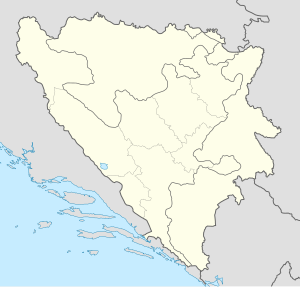| Tuzla Air Base | |
|---|---|
 | |
| Coordinates | 44°27′31″N 18°43′29″E / 44.45861°N 18.72472°E |
| Type | Air Force Base |
| Site history | |
| Built | . |

Members of the Russian honor guard stand by after William S. Cohen, the US Secretary of Defense, arrived at Tuzla Air Base to visit Stabilization Force (SFOR) soldiers in Bosnia-Herzegovina.
Tuzla Air Base is a former SFR Yugoslav Air Force and later, NATO Air Force base, located 6.4 miles (10.3 km) south-southeast of Tuzla, Bosnia and Herzegovina. It also shares the runway with the Tuzla International Airport.
It was used by the United States, Russian, and allied NATO forces, beginning in 1995 as part of the NATO Stabilization Forces (SFOR), which brought peace to Bosnia and Herzegovina. The United States Air Force established the 401st Expeditionary Air Base Group at the base for facilities control and the management of the airfield. The 401st EABG was withdrawn in 2008.
History[]
In the beginning Tuzla was once a small SFR Yugoslav Air Force pilot training base. It was the former home of the 701st Aviation Brigade (Serbo-Croatian: 701. avijacijska brigada / 701. авијацијска бригада). The unit was equipped with the Soko G-2 Galeb at Tuzla and other training aircraft. It was inactivated in December 1990. After its closure it became an unused Cold War relic. It was placed under the control of United Nations Protection Forces in 1992. But the strife in Bosnia-Herzegovina changed that.
NATO Use[]

Emblem of the 401st Expeditionary Air Base Group.
When opposing factions fought each other, the turmoil threatened stability in Europe. The U.N. asked for peace. And with the US -brokered Dayton Peace Accords, the sides agreed to try. But the U.N. ordered 60,000 NATO-led troops into the country to ensure they would. That started Joint Endeavor. But getting troops there would require a huge airlift. At that time, Tuzla's 8,100-foot runway was the countrys best. So it became the receiving end of the airlift. The Air Force flew in and set up to run air operations. Then it started to land and move the 25-nation peacekeeping force and the mountain of supplies and equipment to maintain the force. The airlift went on for several months during which airmen handled an average of 40 cargo planes a day.
US Air Force members of the 4100 Group Provisional, Tanker Airlift Control Element, set up a satellite communication system at the base of the control tower of the airport in Tuzla, Bosnia and Herzegovina, on Dec. 11, 1995. Later, the 401st Expeditionary Air Base Group operated the Predator reconnaissance drones and the airfield for transient NATO and USAF aircraft to maintain the base. During its years of NATO operations, aircraft flew 24-hour reconnaissance and surveillance missions. in support of SFOR, which brought peace to Bosnia and Herzegovina.
The airmen, as part of the NATO Enabling Force of Operation Joint Endeavor, set up operations to bring airfield up to a 24 hour capability. Enabling forces moved into the Croatia, Bosnia and Herzegovina, and Slovenia theaters of operation to prepare entry points for the main Implementation Force. The satellite communication system was used by the operations personnel to keep track of incoming and outgoing aircraft.
The early emphasis was all on getting the job done, not quality of life. Plus, the base couldnt handle all the troops. There was no infrastructure and certainly no amenities. But shortly after the airlift subsided, the Air Force did a complete turnaround. Its focus changed to making life better for troops. It standardized the quality of life in its compound. Troops dubbed it Rock City for the anti-mud crushed rocks that cover parts of it.
Between December 1995 and September 1999 the number of US Army soldiers serving in Bosnia dropped from 18,500 to 6,900. In addition to manpower reductions, other efficiencies have been achieved. Over the past 2 years, the theater's lines of communication have matured significantly. As a result, deploying forces are less dependent on temporary engineer bridges at river crossings, and equipment can be transported by rail all the way into Bosnia.
One of the most significant infrastructure improvements was the opening of Tuzla Air Base in Bosnia to strategic air traffic in October 1998. A major cost-saving action was the decision to maximize the use of pre-positioned equipment. Deploying forces now make full use of a Bosnia equipment set, which reduces the number of heavy vehicles deployed into and out of theater. In addition, the number of US helicopters in Bosnia was reduced by 50 percent, and all US artillery has been withdrawn.
Current status[]
In 1998, the canton of Tuzla turned Tuzla International to a civil airport. Tuzla International opened on 10 October 1998 as a civilian airport and military airfield.
In December 2004 when a European Union-led stabilization force took over the Bosnian peacekeeping mission from NATO. On 1 July 2007, the United States transferred responsibility for the airfield to the Bosnians.
References[]
This article incorporates public domain material from the Air Force Historical Research Agency website http://www.afhra.af.mil/.
External links[]
| ||||||||||||||||
| ||||||||||||||
The original article can be found at Tuzla Air Base and the edit history here.

